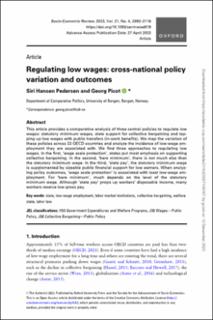| dc.contributor.author | Pedersen, Siri Hansen | |
| dc.contributor.author | Picot, Georg Johannes | |
| dc.date.accessioned | 2024-02-15T10:16:56Z | |
| dc.date.available | 2024-02-15T10:16:56Z | |
| dc.date.created | 2023-05-02T15:40:26Z | |
| dc.date.issued | 2023 | |
| dc.identifier.issn | 1475-1461 | |
| dc.identifier.uri | https://hdl.handle.net/11250/3117938 | |
| dc.description.abstract | This article provides a comparative analysis of three central policies to regulate low wages: statutory minimum wages, state support for collective bargaining and topping up low wages with public transfers (in-work benefits). We map the variation of these policies across 33 OECD countries and analyze the incidence of low-wage employment they are associated with. We find three approaches to regulating low wages. In the first, ‘wage scale protection’, states put most emphasis on supporting collective bargaining. In the second, ‘bare minimum’, there is not much else than the statutory minimum wage. In the third, ‘state pay’, the statutory minimum wage is supplemented by sizeable public financial support for low earners. When analyzing policy outcomes, ‘wage scale protection’ is associated with least low-wage employment. For ‘bare minimum’, much depends on the level of the statutory minimum wage. Although ‘state pay’ props up workers’ disposable income, many workers receive low gross pay. | en_US |
| dc.language.iso | eng | en_US |
| dc.publisher | Oxford University Press | en_US |
| dc.rights | Navngivelse 4.0 Internasjonal | * |
| dc.rights.uri | http://creativecommons.org/licenses/by/4.0/deed.no | * |
| dc.title | Regulating low wages: cross-national policy variation and outcomes | en_US |
| dc.type | Journal article | en_US |
| dc.type | Peer reviewed | en_US |
| dc.description.version | publishedVersion | en_US |
| dc.rights.holder | Copyright 2023 The Author(s) | en_US |
| cristin.ispublished | true | |
| cristin.fulltext | original | |
| cristin.qualitycode | 1 | |
| dc.identifier.doi | 10.1093/ser/mwad019 | |
| dc.identifier.cristin | 2144788 | |
| dc.source.journal | Socio-Economic Review | en_US |
| dc.source.pagenumber | 2093-2116 | en_US |
| dc.relation.project | Norges forskningsråd: 275382 | en_US |
| dc.identifier.citation | Socio-Economic Review. 2023, 21 (4), 2093-2116. | en_US |
| dc.source.volume | 21 | en_US |
| dc.source.issue | 4 | en_US |

